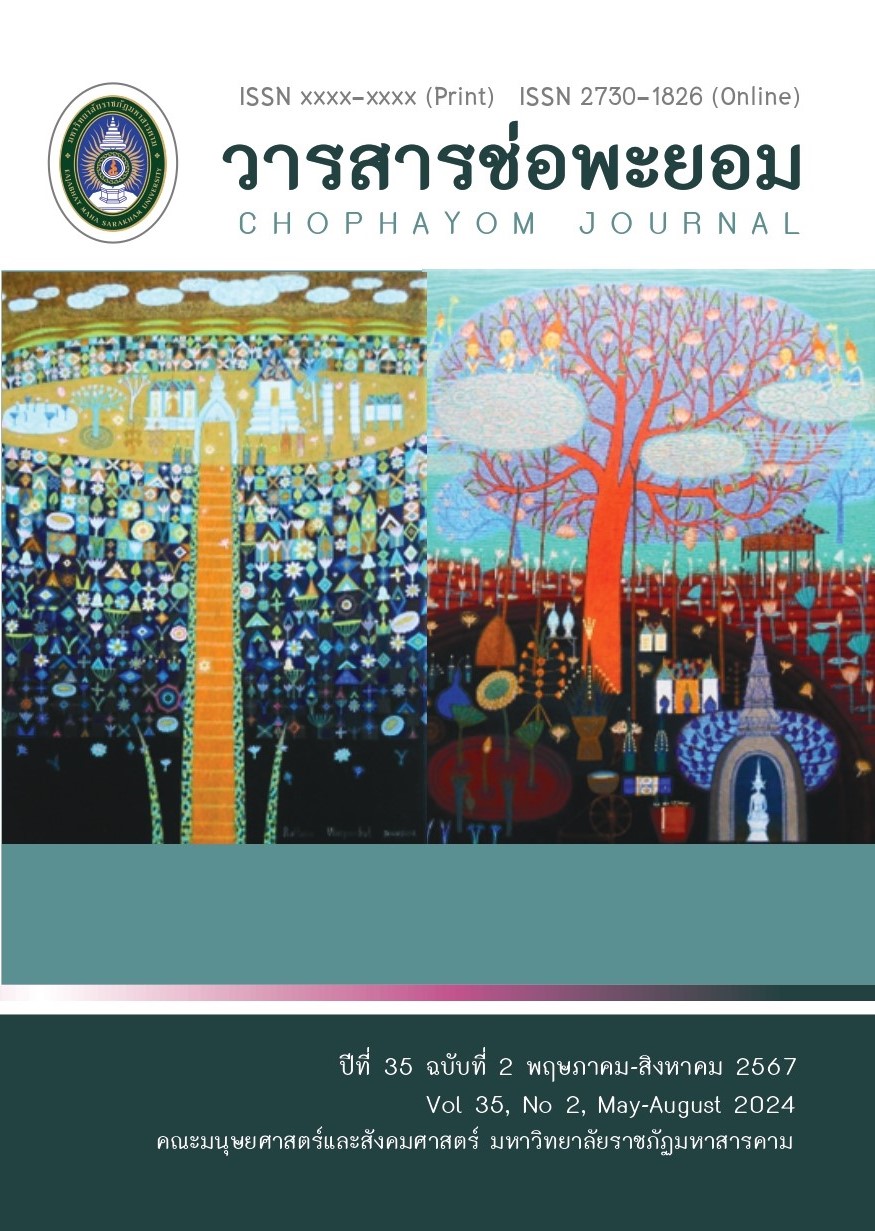Organization Culture and Happy Workplace Affects to Organizational Commitment of The Personnel Local Employees Kanchanadit District Suratthani Province
Keywords:
Local Employees, Organizational Culture, Happy Workplace, Organizational CommitmentAbstract
Currently, government organizations are facing the problem of turnover, and the transfer of civil servants has increased. This is because the global society is becoming more open, making the career of a civil servant unable to meet the needs of these individuals. This research aims to explore a model examining how affects to organizational commitment of the personnel local employees Kanchanadit District, Suratthani Province. The study utilizes a quantitative approach with a sample size of 300 employees, determined using Taro Yamane’s formula. Data collection involved distributing a QR code linked to an electronic questionnaire (Google Form) using simple random sampling. Statistical analyses, including mean, standard deviation, and structural equation modeling, were employed. The development of the questionnaire involved input from three qualified experts, and 30 questionnaire sets were tested. The overall reliability coefficients indicate high confidence in the variables studied: organizational culture of 0.889, happy workplace of 0.838, and organizational commitment of 0.865.
The research findings indicate that the Structural Equation Model (SEM) of organizational culture and happy workplace affects to organizational commitment of the personnel local employees Kanchanadit District Suratthani province, remains consistent with empirical data post-adjustment. This conclusion is supported by statistical indices: the chi-square ratio (X^2/df) of 1.75, the Goodness of Fit Index (GFI) of 0.97, the Comparative Fit Index (CFI) of 0.99, a Root Mean Square Error of Approximation (RMSEA) of 0.05, the Tucker-Lewis Index (TLI) of 0.98, and the Normed Fit Index (NFI) of 0.98. These indices collectively indicate a high level of model fit with the observed data.
Keywords: Local Employees, Organizational Culture, Happy Workplace, Organizational Commitment.
References
กฎชกร บุนนาค และทิพย์วัลย์ สุรินยา. (2562). การเห็นคุณค่าในตนเอง ความสามารถในการฟันฝ่าอุปสรรค กับความสุขในการทำงานของข้าราชการกรมกิจการพลเรือนทหารอากาศ. วารสารมนุษยศาสตร์และสังคมศาสตร์, 7(1), 56-67.
กมลชนก ประสิทธิ์. (2562). ความสัมพันธ์ระหว่างความสุขในการทำงานและความผูกพันของพนักงานธนาคาร ออมสินในจังหวัดอุดรธานี. วารสารวิทยาการจัดการ, 5(1), 102-114.
กุสุมา ศรีแย้ม. (2563). ความสัมพันธ์ของระดับความสุขในการทำงานกับความผูกพันต่อองค์การของพนักงานเจนเนอเรชั่นวาย กรณีศึกษาโรงไฟฟ้าแห่งหนึ่งในเขตภาคตะวันออก. (วิทยานิพนธ์บริหารธุรกิจมหาบัณฑิต, มหาวิทยาลัยบูรพา).
เกียรติยศ ระวะนาวิก และ ศุภชัย ยาวะประภาษ. (2565). การบริหารจัดการที่ดีขององค์กรปกครองส่วนท้องถิ่นในประเทศไทย. วารสาร มจร การพัฒนาสังคม, 7(3), 123-136.
จุฑามาส ตั้งจิตบำรุง. (2562). ความสัมพันธ์ระหว่างการรับรู้เกี่ยวกับลักษณะวัฒนธรรมองค์การกับทัศนคติเกี่ยวกับความสุขและแนวทางการสร้างความสุขในการทำงาน กรณีศึกษาพนักงานประจำสำนักงานโรงงานบริษัทผลิตบรรจุภัณฑ์แห่งหนึ่ง. (สารนิพนธ์รัฐประศาสนศาสตรมหาบัณฑิต, จุฬาลงกรณ์มหาวิทยาลัย).
ชฎาภรณ์ เพียยุระ. (2565). คุณภาพชีวิตในการทำงานและวัฒนธรรมองค์การที่ส่งผลต่อความผูกพันต่อ องค์กรของบุคลากรองค์กรปกครองส่วนท้องถิ่น ในเขตอำเภอพรรณานิคม จังหวัดสกลนคร. (วิทยานิพนธ์รัฐประศาสนศาสตรมหาบัณฑิต, มหาวิทยาลัยราชภัฏสกลนคร).
ชิดชนก ศรีรักษ์และ ปัญญา ศรีสิงห์. (2563). ปัจจัยที่ส่งผลต่อการลาออกและโอนย้าย ของข้าราชการกรมส่งเสริมการค้าระหว่างประเทศ. วารสารสมาคมนักวิจัย, 25(2), 308-322.
ณัฏฐนันท์ อ่ำขวัญยืน และจิราพร ระโหฐาน. (2566). ความยุติธรรมในองค์กรและคุณภาพชีวิตในการทำงาน ที่มีผลต่อความผูกพันต่อองค์กรของบุคลากรเทศบาลเมืองบ้านสวน จังหวัดชลบุรี. วารสารสหวิทยาการมนุษยศาสตร์และสังคมศาสตร์, 6(2), 1014-1028.
ธัญพิชชา สามารถ. (2564). ความผูกพันต่อองค์การของบุคลากรเทศบาลเมืองในจังหวัดชลบุรี. (สารนิพนธ์รัฐประศาสนศาสตรมหาบัณฑิต, มหาวิทยาลัยบูรพา).
พรรณปพร สื่อกลาง สัญญาศรณ์ สวัสดิ์ไธสง และ ชาติชัย อุดมกิจมงคล. (2564). จิตวิญญาณในการทำงานและการรับรู้วัฒนธรรมองค์การที่ส่งผลต่อความผูกพันในงานของบุคลากรองค์กรปกครองส่วนท้องถิ่นในเขตอำเภอบ้านดุง จังหวัดอุดรธานี. วารสารบัณฑิตศึกษา, 18(81), 81-91.
มาศญา ศรีสุข. (2564). ปัจจัยที่มีอิทธิพลต่อการตัดสินใจเข้ารับหรือไม่รับราชการของคนรุ่นใหม่ที่จบการศึกษาจากสาขาวิชาที่มีวิชาชีพเฉพาะกรณีศึกษา สาขาวิชาบัญชีและการเงิน. (สารนิพนธ์รัฐประศาสนศาสตรมหาบัณฑิต, จุฬาลงกรณ์มหาวิทยาลัย)
วรรณภา ศรีมุกดา และ ลัดดาวรรณ ณ ระนอง. (2564). อิทธิพลของคุณภาพชีวิตในการทำงานและความสุข ในการทำงานที่ส่งผลต่อความผูกพันของบุคลากร องค์การบริหารส่วนจังหวัดสกลนคร. วารสารราชพฤกษ์, 11(3), 83-91.
ศักดิ์ชัย จันทะแสง. (2566). วัฒนธรรมองค์กรและคุณภาพชีวิตการทำงานที่ส่งผลต่อพฤติกรรมการเป็นสมาชิกที่ดีขององค์กรของบุคลากรสายสนับสนุนมหาวิทยาลัยเทคโนโลยีราชมงคลกรุงเทพ. วารสารสังคมศาสตร์วิจัย, 14(1), 89-109.
ศุภาพิชญ์ อินแตง. (2565). วัฒนธรรมองค์กรที่ส่งผลต่อความสุขในการทำงานของกลุ่มเจนเนอร์เรชั่นวาย ในเขตกรุงเทพมหานครและปริมณฑล. (สารนิพนธ์การจัดการมหาบัณฑิต, มหาวิทยาลัยมหิดล).
สำนักงานพัฒนาชุมชนอำเภอกาญจนดิษฐ์. (2562). จำนวนองค์กรปกครองส่วนท้องถิ่นในอำเภอกาญจนดิษฐ์. สืบค้นเมื่อ 14 มิถุนายน 2567, จาก https://district.cdd.go.th/kanchanadit/about-us/ประวัติความเป็นมา/.
สำนักงานส่งเสริมการปกครองท้องถิ่นจังหวัดสุราษฎร์ธานี. (2567). การบริหารงานบุคคล. สืบค้นเมื่อ 14 มิถุนายน 2567, จาก https://www.surat-local.go.th/frontpage.
สุกริน ทวีสุต. (2562). ปัจจัยสภาพแวดล้อมในการทำงานที่สัมพันธ์กับความสุขในการทำงานของบุคลากรเทศบาลนครหาดใหญ่. (สารนิพนธ์รัฐประศาสนศาสตรมหาบัณฑิต, มหาวิทยาลัยสงขลานครินทร์).
Akpa, V. O., Asikhia, O. U., & Nneji, N. E. (2021). Organizational culture and organizational performance: A review of literature International. Journal of Advances in Engineering and Management, 3(1), 361-372.
Alijanzadeh, M., Kalhor, R., & Joftyar, M. (2018). Organizational culture in Qazvin University of Medical Sciences: based on the Denison Model. Int J BioMed Public Health, 1(4), 187-192.
Denison, D. R. (1990). Corporate culture and organizational effectiveness. New York, NY: John Wiley & Sons.
Fornell, C., & Larcker, D. F. (1981). Evaluating Structural Equation Models with Unobservable and Measurement Error. Journal of Marketing Research. 34(2), 161-188.
Hair, J. F. (Jr.) Hult, G. T. M., Ringle, C. M., and Sarstedt, M. (2014). A Primer on Partial Least Squares Structural equation Model ing (PLS-SEM). California, CA: Sage Publications.
Hair, J. F., Black, W. C., Babin, B. J., and Anderson, R. E. (2010). Multivariate Data Analysis.7 th ed. Upper Saddle River, NJ : Prentice-Hall.
Manion, J. (2003). Joy at work: Creating a positive workplace. Journal of Nursing Administration, 33(12), 652-655.
Mowday, R., Porter, L. & Steers, R. (1982). Employee Organization Linkages: The Psychology of Commitment, Absenteeism, and Turnover. New York: Academic Press.
Saiga, E., & Yoshioka, S. I. (2021). Factors Influencing the Happiness of Japanese Nurses: Association with Work Engagement and Workaholism. Kawasaki J Med Welf, 26(2), 81-93.
Downloads
Published
How to Cite
Issue
Section
License
Copyright (c) 2024 Chophayom Journal

This work is licensed under a Creative Commons Attribution-NonCommercial-NoDerivatives 4.0 International License.






